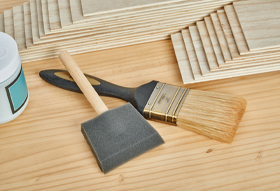
Foam Paint Brushes | Polyurethane Foam Brush | DIY Sponge Paint Brush

Home DIY and painting – we either love it or hate it. One of the most common complaints from those undertaking painting tasks is the cleaning of all the materials after the job is complete. Given that interior wall paints are fairly heavy-duty, cleaning brushes is not the most thrilling of tasks. Second to that, finding stray pieces of shredded paintbrush on your freshly painted wall is another frustrating result.
Instead of using traditional paint brushes which are typically made from nylon, polyester threads or natural bristles, foam is a fantastic alternative. Whether you decide to order foam tools especially for the job, or use left-over foam offcuts from a separate DIY project, the result is just as good. A frequent issue experienced when using fibre brushes is the streaky distribution of paint. Given the density of the fibres and/or natural bristles of conventional brushes, a significant amount of paint can be trapped within the brush rather than transferred onto a wall. This is also what makes cleaning brushes so difficult.
In comparison, soft-medium density polyurethane foam brushes better absorbs and distributes paint in comparison to traditional brushes. Part of its absorption properties also ensures that paint drippage is reduced. Unlike bristles that can leave streaky marks, foam paint brushes or 'sponge paint brushes' are multi-purpose, and are suitable for a range of tasks including the application of wood finishes to doors, floors and furniture, as well as the application of water-based stains, waxes, oils and dyes. However, it is worth noting that foam is not recommended for use with solvent-based products.

Not sure if foam paint brushes are for you? Further example uses of foam tools in place of traditional brushes include the application of oils to parquet flooring, ‘cutting in’ paint around kitchen hobs and sinks, touching up scratch marks on smooth walls and applying floor sealant.
Another perk brought by using a foam brush is that your tool can be fully customisable to your exact specifications. For example, instead of a rectangular bristle-based brush, your foam could have a tapered head to ensure better straight edge application. In turn, this makes foam a better tool for finishing intricate areas and corners. Alternatively, you can order a foam brush that is entirely different, such as a circular foam paint dabber. These are marshmallow-shaped, and can be easily attached to a stick for better handling and control. If you’d prefer to apply a paint, stain or dye in a particular pattern, these tools are also excellent for stamping and making intricate patterns. Whatever tool shape you choose, eFoam’s cut to size capabilities mean that you can order your foam brush in any shape or size you desire.
Alongside the practical benefits of using foam paint brushes, there are several environmental benefits. Polyurethane foams supplied by eFoam are both washable and of a non-toxic composition, meaning they won’t end up in landfill and are safe for a range of uses (including children’s paint-based activities). Naturally, this also makes foam tools a far more cost-effective option, particularly if you are an avid painter or DIY crafter!
Should you require any assistance when ordering foam for your paint brushes and tools, please contact one of our friendly advisors.

